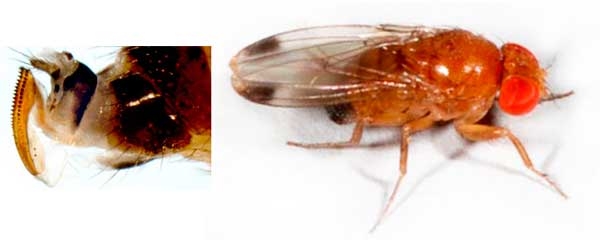Spotted wing drosophila (Drosophila suzukii) is a close relative of the common vinegar fly (Drosophila melanogaster).
The vinegar fly cannot lay its eggs under the skin of the fruit and comes in only when the skin of the fruit is broken and fermentation has started, so it is of little or no commercial significance. Spotted wing drosophila is its nasty cousin.
The ovipositor on the spotted wing drosophila is hardened and serrated. It is able to penetrate the skin of soft fruit like cherries, plums, blackberries, Asian pears, raspberries, blueberries and the like, close to harvest to lay its eggs.
This leads to deformations in the fruit and a cluster of little maggots feeding under the skin. The fruit quickly collapses and rots. If uncontrolled, it is capable of taking out 50% of a cherry crop and making the rest suspect.
Life cycle and behaviour
Spotted wing drosophila is a tiny insect. Adult flies are about 3 mm long. A female can lay up to 600 eggs and egg to adult can take one week in warm weather.
They can survive as adults through winter in Ontario, Canada, so there is nowhere in Australia where cold conditions would limit them. Their optimum temperature is 20C.
History
Spotted wing drosophila was first identified by a Japanese entomologist (hence the species name suzukii).
Scientific publications relating to the pest status and attempts at control of this insect in Japan go way back.
About eight years ago it turned up in cherry orchards and berry fruit plantings in California and the Pacific northwest of USA. It has since spread across the continent.
It is now present in Europe, causing the same problems there. It recently turned up in Chile & Brazil.
It was unheard of in China until about five years ago. Their appearance followed a substantial increase in cherry plantings—now around 80,000 hectares.
(continued next month)
See this article in Tree Fruit March 2017




















